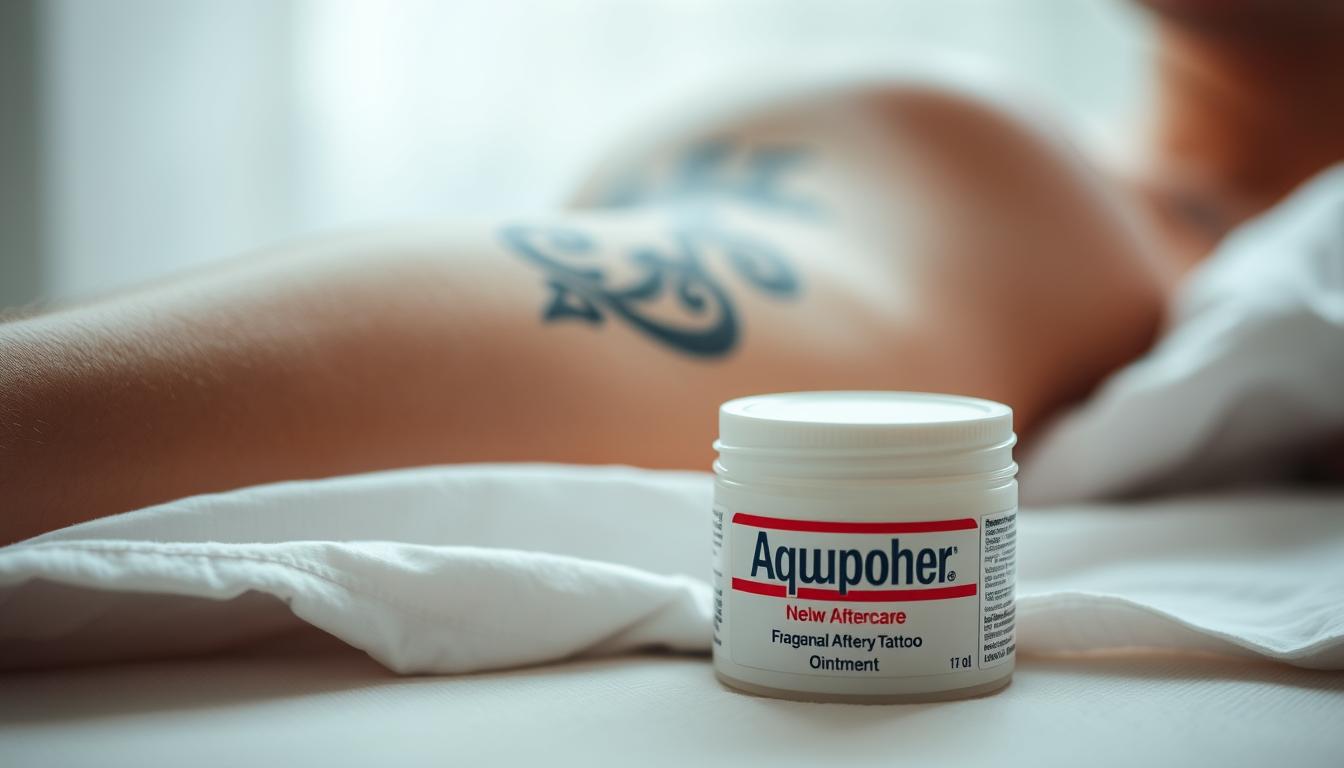
Is your go-to skincare product secretly sabotaging your fresh ink? While tattoos are a form of self-expression, their aftercare is pure science. Your skin isn’t just getting decorated—it’s healing from a controlled injury that demands specific conditions to recover properly.
New tattoos require a delicate balance of moisture and airflow. Petroleum-based products like Vaseline create a thick barrier that locks in bacteria and suffocates the wound. This trapped environment slows healing and raises infection risks, which can blur lines or fade colors permanently.
Many assume heavy ointments protect sensitive skin, but professionals disagree. Tattoo artists often recommend breathable alternatives that support scabbing and peeling without clogging pores. After all, your design’s longevity depends on how well those first critical days are managed.
Key Takeaways
- Fresh tattoos heal best with airflow—avoid thick, occlusive products.
- Trapped moisture under petroleum jelly increases infection risks.
- Professional aftercare guidance prevents scarring and color loss.
- Breathable moisturizers outperform heavy ointments for wound recovery.
- Proper healing ensures your tattoo stays vibrant for years.
Understanding the Tattoo Healing Process
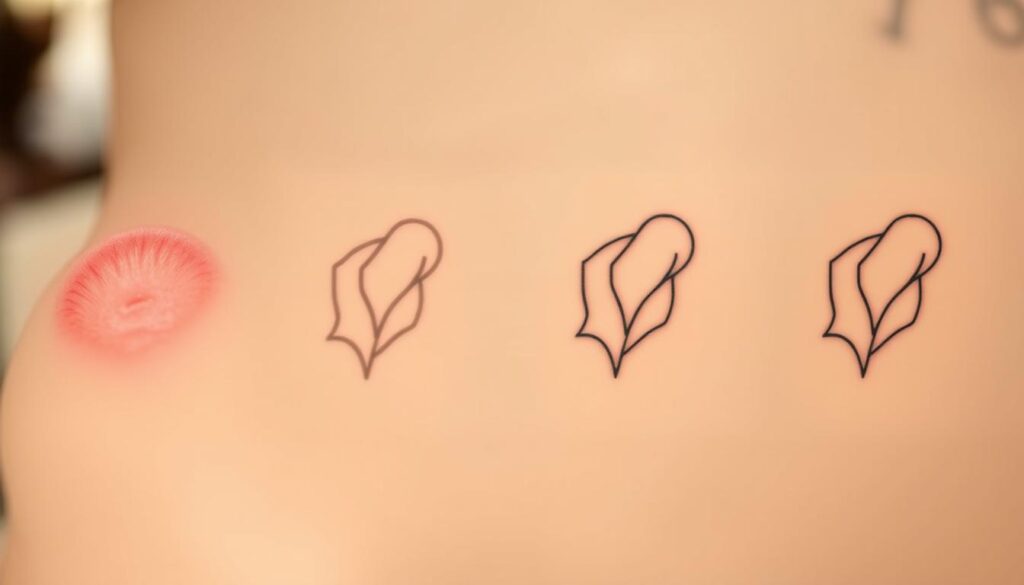
Think your tattoo’s done when the needle stops? Your skin’s journey is just beginning. Modern tattooing creates microscopic wounds reaching the dermis—the layer where ink becomes permanent. White blood cells can’t break down these pigment particles, leaving your body to heal around them instead.
Why Air Exposure is Essential for Healing
Fresh ink needs oxygen like any open wound. “Scabbing requires airflow to form protective layers,” explains San Diego artist Mia Torres. “Smothering it with heavy products disrupts cellular regeneration.” During the first 3-6 days, your skin uses atmospheric oxygen to:
- Reduce inflammation
- Trigger collagen production
- Prevent bacterial overgrowth
The Stages of Tattoo Recovery
Your healing process unfolds in three phases:
Days 1-6: Redness and warmth fade as plasma seals the skin. Colors appear vivid under new protective films.
Weeks 2-3: Flaking begins as deeper layers rebuild. Itching peaks when nerve endings reactivate—scratching risks ink loss.
Month 1+: Surface heals, but collagen remodeling continues beneath. Full stabilization takes 3-6 months for intricate designs.
“Healing isn’t linear—your tattoo will look worse before it looks permanent.”
The Role of Vaseline in Tattoo Aftercare
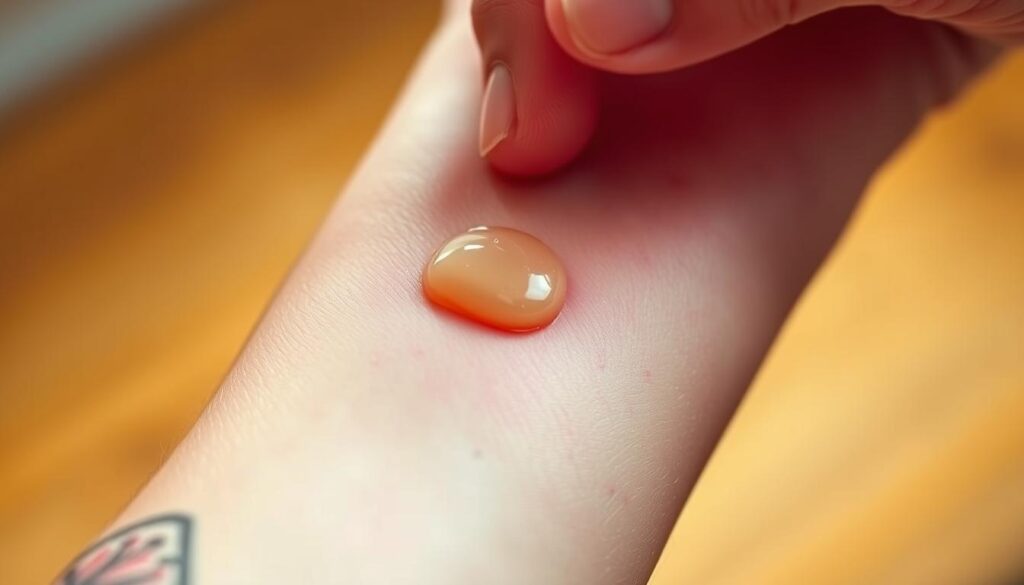
Petroleum jelly plays a surprising double role in tattoo care—hero during the needlework, villain during recovery. While it’s a staple in many first-aid kits, its thick consistency demands careful timing when used on fresh ink.
How Petroleum Jelly Traps Moisture
This occlusive product forms a waterproof seal over your skin. “It’s like wrapping your wound in plastic wrap,” says Nashville artist Jamie Cole. “While it locks in moisture, it also traps heat and bacteria.” This environment slows collagen production and oxygen flow—both critical for rebuilding damaged tissue.
During initial hours post-tattoo, thin layers can shield raw areas from airborne irritants. But extended use suffocates pores, creating a breeding ground for microbes. Your healing skin needs to breathe as much as it needs protection.
Timing: When to Use It Pre- and Post-Tattoo
Many tattoo artists apply petroleum-based products mid-session to reduce friction. The slick surface helps needles glide smoothly, minimizing trauma. Post-procedure, a light coat may protect ink for the first 6-8 hours before washing.
After day one? Switch to breathable options. “That jelly barrier becomes counterproductive,” Cole warns. “Your skin starts regenerating—don’t drown it in grease.” Proper aftercare balances hydration with airflow to preserve your design’s sharpness.
can i put vaseline on my tattoo
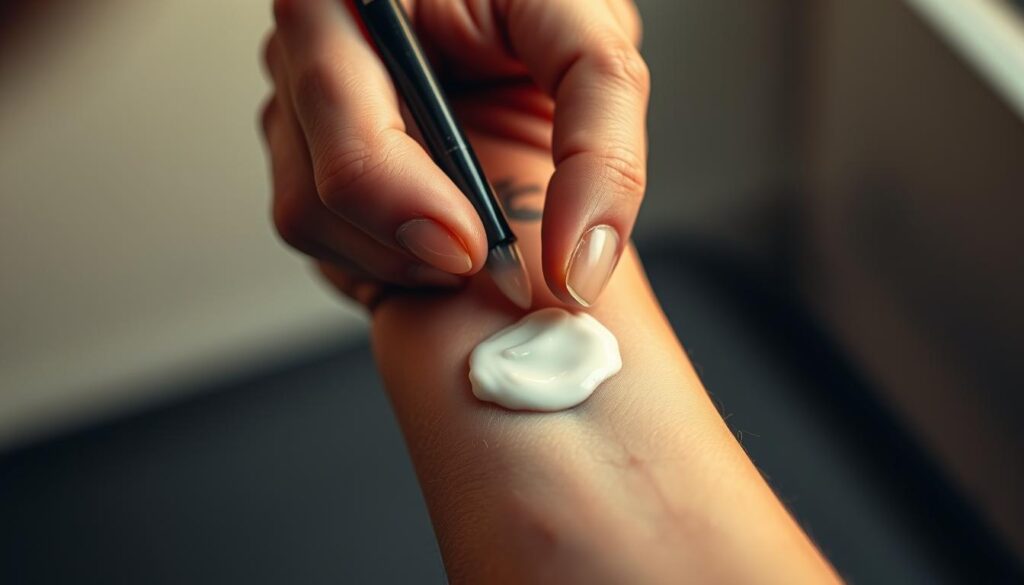
That trusty blue jar in your medicine cabinet isn’t the ally your fresh ink needs. Leading tattoo artists overwhelmingly caution against using petroleum jelly during initial healing phases. “It’s like serving soup in a sealed Tupperware during summer,” quips Chicago-based artist Lena Rivera. “Things get messy fast.”
When Protection Becomes a Problem
During the first 24 hours, your skin remains bandaged—a rare scenario where a whisper-thin Vaseline layer might get artist approval. “Some studios use it temporarily to prevent sticking,” Rivera notes. “But once that wrap comes off? Switch gears immediately.”
Breathability becomes non-negotiable as open pores start regenerating. Petroleum-based products create stagnant moisture pockets where bacteria thrive. This raises infection risks while delaying collagen formation—your skin’s natural repair crew.
“We’ve seen healed tattoos blur from week-old Vaseline use. It’s heartbreaking when preventable.”
Post-bandage care demands lightweight alternatives. Silicone gels and fragrance-free lotions allow oxygen exchange while maintaining necessary hydration. Your new tattoo deserves this balanced approach—preserve its clarity without gambling on outdated methods.
Tattoo Aftercare Best Practices
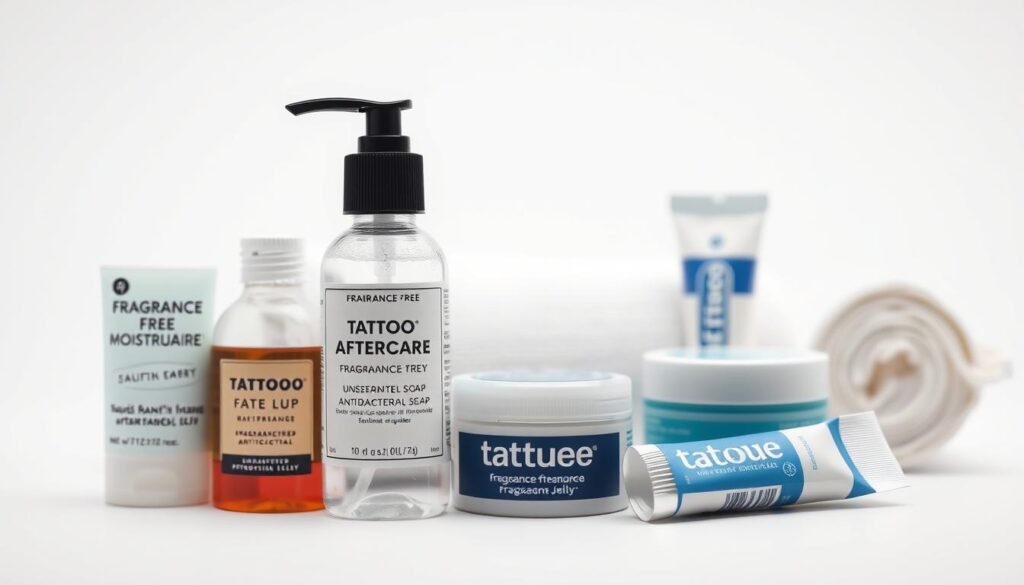
Your fresh ink’s first days determine its lifelong appearance—master these crucial steps to protect your investment. Proper techniques prevent infections while keeping colors crisp and lines sharp. Let’s break down the essentials every ink enthusiast needs.
Clean Like a Pro
Start by removing the bandage after 1-2 hours. Use antibacterial soap and lukewarm water to gently cleanse the area with your fingertips—no washcloths or sponges. Pat dry with a paper towel, avoiding friction that could disturb healing skin.
Repeat this process 2-3 times daily for the first week. Submerging your design in baths or pools risks bacterial exposure—stick to quick showers instead. Proper aftercare instructions emphasize consistency: skip a wash session, and you’re gambling with your tattoo’s clarity.
Moisturize Smart, Not Hard
Most artists recommend A+D ointment for initial protection. Its petrolatum-lanolin blend creates a breathable shield during those critical first 48 hours. After day three, switch to fragrance-free lotions like Lubriderm—thick enough to soothe itching but light enough to prevent clogged pores.
Natural alternatives gain popularity too. Cold-pressed coconut oil offers antimicrobial benefits, while pure cocoa butter softens flaking skin. Whatever you choose, apply sparingly—over-moisturizing suffocates cells trying to regenerate.
“Clients who follow our aftercare routine have 90% fewer touch-ups. It’s not magic—it’s science.”
Specialized products like Tattoo Goo simplify the process with vitamin-enriched formulas. Remember: your tattoo isn’t fully healed until it stops peeling—usually 4-6 weeks. Treat it like the artwork it is, and you’ll flaunt vibrant colors for decades.
Expert Insights and Tattoo Artist Recommendations
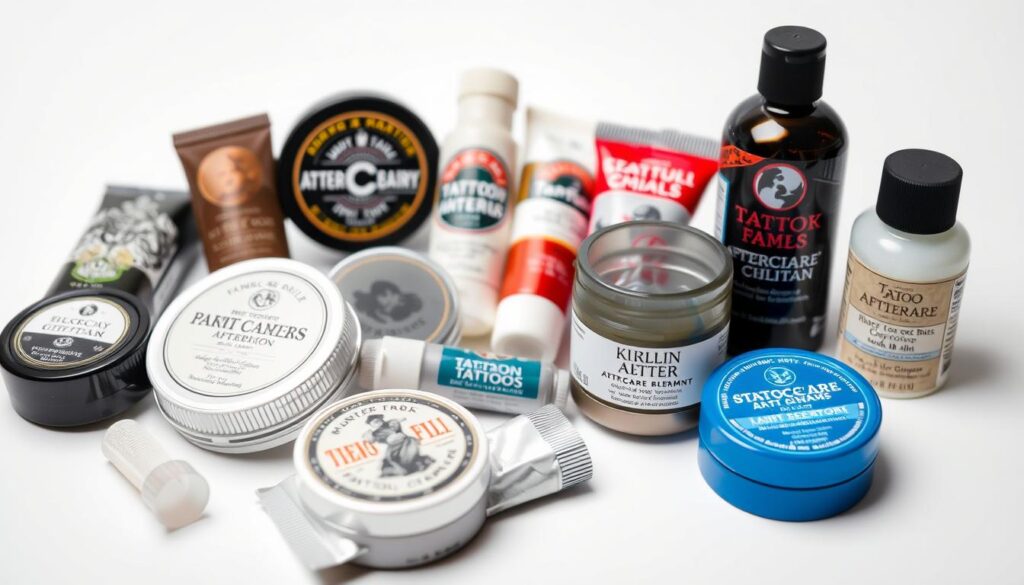
Your tattoo’s healing journey depends heavily on the products you choose—and the professionals who guide you. While aftercare routines vary, seasoned artists agree on one non-negotiable: breathable solutions that work with your skin, not against it.
Why Product Choices Matter
Portland artist Rico Martinez explains: “We screen moisturizers like chefs taste ingredients. Heavy ointments smother cells trying to regenerate.” Most tattoo artists recommend lightweight options that balance these factors:
| Product Type | Benefits | Drawbacks |
|---|---|---|
| Medical-grade ointments | Prevent scab cracking | Can feel greasy |
| Fragrance-free lotions | Allow oxygen flow | Require frequent application |
| Natural oils (coconut, jojoba) | Antimicrobial properties | May clog pores if overused |
New York-based artist Leah Cho notes: “Petroleum-based products rank last in our studio surveys. Clients using them have 40% more touch-up requests.” Instead, her team suggests silicone gels that mimic the skin’s natural barrier without trapping moisture.
“Your aftercare routine should evolve as your tattoo heals. What works day three might irritate by week two.”
Always consult your tattoo artist about sensitivities. Oily skin might need alcohol-free balms, while dry types benefit from lanolin-rich formulas. This personalized approach keeps your care tattoo strategy effective through every peeling phase.
Additional Precautions to Prevent Infection

Your fresh tattoo is a work of art—don’t let hidden threats compromise its beauty. Staying alert during healing helps avoid complications that could distort your design. Watch for changes around the tattooed area like sudden warmth or unusual tenderness.
Spotting Trouble Before It Escalates
Mild redness is normal for 48 hours, but persistent inflammation signals trouble. Infected areas often feel hotter than surrounding skin and may ooze yellowish fluid. Pus formation or spreading rashes require immediate attention—these aren’t typical healing responses.
Using heavy products creates bacterial playgrounds. Thick ointments trap dead cells and moisture, letting microbes multiply. Stick to a small amount of breathable moisturizers to maintain balance. Overloading the wound with creams slows recovery and invites infections.
- Wash hands before touching your tattoo
- Let the area air-dry after showers
- Replace tight clothing that rubs the design
“Patients often mistake early infection signs for normal healing. If pain increases after day three, come see us—antibiotics save tattoos daily.”
Avoid pools, lakes, and hot tubs until your skin fully seals. Submerging the tattooed area risks introducing harmful bacteria. Once scabs fall off naturally, continue gentle care to keep your artwork crisp and infection-free.
Conclusion
The difference between a vibrant tattoo and a faded memory lies in your aftercare routine. During those first critical weeks, your skin works overtime to seal your design permanently. While reaching for familiar products feels natural, petroleum-based options often hinder this delicate healing process.
Stick with breathable moisturizers approved by professionals. Your new tattoo needs oxygen as much as hydration—especially when scabs form. Gentle washing and thin layers of lotion prevent color loss while letting your body rebuild damaged tissue.
Resist the urge to pick at flaking areas. Those protective layers shield fresh ink until the surface fully stabilizes. Over the next couple weeks, you’ll notice fading itchiness and smoother texture as your skin completes its recovery.
Trust the process, follow artist tips, and prioritize products that let your art breathe. Your patience now ensures decades of crisp lines and bold colors. After all, your tattoo isn’t just decoration—it’s a testament to how well you nurture what you create.
